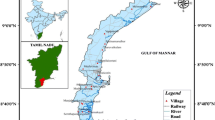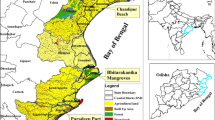Abstract
Coastal hazards in many areas of the world are increasing as a result of rapid changes in various geological and physical variables driven by dynamic coastal processes. Development activities, global warming, climate change and sea-level rise not only introduce any new types of coastal hazards, but they also affect the existing hazards. The southern coastal Tamil Nadu of India faces severe threat due to rapid changes in geology and geomorphology, sea-level change, tropical cyclones and associated storm surges. In this present work, erosion hazard and vulnerability level along the southern coastal Tamil Nadu have been assessed using remote sensing and GIS. The erosion and accretion made in different parts of the study area have been measured and analysed. The coastal vulnerability index (CVI) has been used to map the relative vulnerability along the study area. The CVI ranks both geological and physical variables in terms of their physical contribution to sea-level rise and vulnerability. The data within the coastal vulnerability index show significant variability at different spatial scales. The vulnerability is caused by a complex interaction of various natural and human-induced coastal processes. The natural processes due to geology and geomorphology, the combined action of waves and currents, variations in sea level, tectonics and storms affect the vulnerability. The human activities include manipulation of hydrological cycles through construction of buildings along beaches, coastal structures such as harbours, beach protecting structures and jetties, mining of beach sand, destruction of protective dune systems. Thus, the present study clearly focuses on the vulnerability and risk parameters along the study area. It is also recommended that proper coastal management plans, beach filling and nourishment projects should be made to save the coastal area from severe erosion threat and hazards.









Similar content being viewed by others
References
Angusamy N, Rajamanickam GV (2000) Distribution of heavy minerals along the beaches from Mandapam to Kanyakumari, Tamilnadu. J Geol Soc India 56(8):199–211
Arthurton R (1992) Beach erosion: case studies on the east African coast. In: Proceedings of Bordeaux, International convention on rational use of the coastal zone. IOC, Bordeaux, pp 91–95
Bruun P (1962) Sealevel rise as a cause of shore erosion. J Waterw Harb Div 88:117–130
Chandramohan P, Jena BK, Sanil Kumar V (2001) Littoral drift sources and sinks along the Indian coast. Curr Sci 81(3):292–297
Chauhan P, Nayak S, Ramesh R, Krishnamoorthy R, Ramachandran S (1996) Remote sensing of suspended sediments along the Tamil Nadu coastal waters. J Indian Soc Remote Sens 24(3):105–114
Cutter SL, Mitchell JT, Scott MS (2000) Revealing the vulnerability of people and places: a case study of Georgetown County, South Carolina. Ann As Am Geogr 90(4):713–737
Dean RG, Dalrymple RA (1991) Water wave mechanics for engineers and scientists. Singapore, World Scientific Press, p 353
Dean RG, Dalrymple RA (2004) Coastal processes with engineering applications, Cambridge University Press, p 475
Ferraras SF, Pararas-Carayannis G (1988) Natural and man-made coastal hazards, Proceedings of the 3rd international conference on natural and man-made coastal hazards held in August 15–20, 1988. Ensenada, Baja California, pp 37–42
Gornitz VM, Daniels RC, White TW, Birdwell KR (1994) The development of a coastal vulnerability assessment database, vulnerability to sea-level rise in the U.S. southeast. J Coast Res 12:327–338
Hung CW, Chen HB, Tsai CP (2008) Simulation of shoreline change behind a submerged permeable breakwater, Taiwan-polish Joint seminar on coastal protection, Taiwan, pp 49–58
Hilton MJ (1994) Applying the principles of sustainability to coastal sand mining: the case of Pakiri-Mangawhai beach, New Zealand. Environ Manage 18(6):815–829
IOC Manuals and Guides No. 40 (2000) UNESCO-2000, p 55
Jacob K (1956) Ilmenite and garnet sands of the Chowghat (west coast) Tinnevelly Ramnad and Tanjore coasts (East coast). Roc Geol Surv India 82(4):567–602
Johnson DW (1919) Shore processes and shoreline development. New York, Wiley, pp 584 (Reprinted by Hafner Pub. Co., New York)
Kairu K, Nyandwi N (2000) Guidelines for the study of shoreline change in the western Indian Ocean region, IOC manuals and guides No. 40, UNESCO, p 55
Kato H, EANHMP (2002) Eastern Asia natural hazard mapping project. Explanatory note of East Asia geological hazards map, Geological Survey of Japan, AIST, p 584
King DB (1974) The dynamics of inlets and bays. Technical report no. 2 coastal and oceanographic engineering laboratory. University of Florida, Gainesville
Loveson VJ, Rajamanickam VG (1987) Coastal geomorphology of the south Tamilnadu, India. In: Bhan RK, Jha VK (eds) Proceedings on national symposium remote sensing in land transformation and management, Hyderabad, pp 115–129
Loveson VJ, Angusamy N, Rajamanickam GV (1996) Usefulness of identifying different geomorphic blocks along the coast of southern Tamilnadu. Indian J Geomorphol 01:97–110
Mei CC (1983) The applied dynamics of ocean surface waves. Wiley Inter science, New York and World Scientific Press, Singapore, p 740
Mujabar S (2010) Quantitative analysis of coastal landform dynamics between Tuticorin and Kanyakumari by using remote sensing and GIS Ph.D.-Thesis. Manonmaniam Sundaranar University, India
Mukesh SB (2010) Coastal vulnerability, adaptation and risk assessment due to environmental change in Apodi Mossoro estuary, Northeast Brazil. Int J Geomat Geosci 1(3):620–638
Munich R (2000) Natural catastrophes: the current position. Special Millennium Issue, Munich R Group, Munich Reinsurance Company, p 126
Namboothri N, Subramanian D, Muthuraman B, Sridhar A, Rodriguez S, Shanker K (2008) Beyond the Tsunami: coastal sand dunes of Tamil Nadu, India- an overview. UNDP/UNTRS Chennai and ATREE, Bangalore, p 56
Nayak S (1992) Coastal environment. scientific note, space applications centre, Ahmedabad. RSAM/SAC/COM/SN/11/92, p 114
Nayak S (2002) Use of satellite data in coastal mapping. Indian Cartogr 22:147–156
Nyandwi N (2001) Survey of extent of human-induced beach erosion problems in Tanzania. In: Richmond MD, Francis J (eds) Marine science development in Tanzania and eastern Africa. pp 121–129
Pendleton EA, Hammarklose ES, Thieler ER, Williams SJ (2003) Coastal vulnerability assessment of Gulf Islands national seashore (GUIS) to sealevel rise. US geological survey openfile report 03108; Available online at http://pubs.usgs.gov/of/2003/of03108/images/pdf/Gulf_Islands_www.pdf
Pendleton EA, Thieler ER, Williams SJ (2010) Importance of coastal change variables in determining vulnerability to sea- and lake-level change. J Coastal Res 26(1):176–183
Rao DS, Vijayakumar TV, Prabhakar S, Bhaskar Raju G, Ghosh TK (2005) Alteration characteristics of ilmenites from south India. J Miner Mater Charact Eng 4(1):47–59
Sekhar LK, Jayadev SK (2003) Karimanal, mining in the Alappuzha coast of Kerala—a people’s perspective. In: Proceedings of the third international conference on environment and health, Chennai, India Chennai: department of geography, University of Madras and faculty of environmental studies, York University. pp 470–488
Shaw J, Taylor RB, Forbes DL, Ruz MH, Solomon S (1998) Sensitivity of the Canadian coast to sea-level rise: geological survey of Canada Bulletin, 505, p 114
Shepard FP (1963) Submarine geology, 2nd edn. Harper and Row, New York, p 557
Thieler ER, Hammar-Klose ES (1999) National assessment of coastal vulnerability to sea-level rise, US Atlantic Coast: US Geological survey, Open-file report, pp 99–593
Valentine H (1952) Die Ku stender Erde, Petermanns Geog. Mitt., Erga¨nzungsheft, p 246
Warrick RA, Le Provost C, Meier MF, Oerlemans J, Woodworth PL (1996) Changes in sea level. In: Climate change 1995, Intergovernmental panel on climate change. Cambridge University press, p 258
Wiegel RL (1964) Oceanographical engineering, Englewood cliffs, NJ, Prentice–Hall, p 532
Work PA, Otay EN (1996) Influence of near shore berm on beach nourishment. In: Proceedings of 25th International Conference on Coastal Engineering, ASCE, New York, NY, pp 3722–3749
Acknowledgments
The authors are thankful to Dr. Bhoop Singh, Director, NRDMS, Department of Science and Technology, New Delhi, for his kind help in completing the wok. The authors are also thankful to Department of Science and Technology, New Delhi, for providing the financial assistance under NRDMS Scheme (ES/11/546/2000 and ES/11/936(5)/05). The corresponding thanks to Dr.M. Mohamed Sidiqqe, Principal, National College of Engineering, Tirunelveli, for his kind help and cooperation.
Author information
Authors and Affiliations
Corresponding author
Rights and permissions
About this article
Cite this article
Sheik Mujabar, P., Chandrasekar, N. Coastal erosion hazard and vulnerability assessment for southern coastal Tamil Nadu of India by using remote sensing and GIS. Nat Hazards 69, 1295–1314 (2013). https://doi.org/10.1007/s11069-011-9962-x
Received:
Accepted:
Published:
Issue Date:
DOI: https://doi.org/10.1007/s11069-011-9962-x




